Controllable Nano-Crystallization in Fluoroborosilicate Glass Ceramics for Broadband Visible Photoluminescence
Abstract
:1. Introduction
2. Experimental
2.1. Materials and Preparations
2.2. Characterization
3. Results and Discussion
4. Conclusions
Author Contributions
Funding
Institutional Review Board Statement
Informed Consent Statement
Data Availability Statement
Conflicts of Interest
References
- Xu, X.H.; Zhang, W.F.; Yang, D.C.; Lu, W.; Qiu, J.B.; Yu, S.F. Phonon-assisted population inversion in lanthanide-doped upconversion Ba2LaF7 nanocrystals in glass-ceramics. Adv. Mater. 2016, 28, 8045–8050. [Google Scholar] [CrossRef] [PubMed]
- Zhang, W.J.; Zhang, J.P.; Wang, Z.; Wang, W.C.; Zhang, Q.Y. Spectroscopic and structural characterization of transparent fluorogermanate glass ceramics with LaF3:Tm3+ nanocrystals for optical amplifications. J. Alloys Compd. 2015, 634, 122–129. [Google Scholar] [CrossRef]
- Jia, Z.X.; Yao, C.F.; Jia, S.J.; Wang, F.; Wang, S.B.; Zhao, Z.P.; Qin, G.S.; Ohishi, Y.; Qin, W.P. 4.5 W supercontinuum generation from 1017 to 3438 nm in an all-solid fluorotellurite fiber. Appl. Phys. Lett. 2017, 110, 261106. [Google Scholar] [CrossRef]
- Galleani, G.; Bradtmüller, H.; Fares, H.; Santagneli, S.H.; Nalin, M.; Eckert, H. BiF3 incorporation in Na/Ba mixed network modifier fluoride-phosphate glasses: Structural studies by solid-state NMR and raman spectroscopies. J. Phys. Chem. C 2020, 124, 25578–25587. [Google Scholar] [CrossRef]
- Zhao, J.J.; Ma, R.; Chen, X.K.; Kang, B.B.; Qiao, X.S.; Du, J.C.; Fan, X.P.; Ross, U.; Roiland, C.; Lotnyk, A.; et al. From phase separation to nanocrystallization in fluorosilicate glasses: Structural design of highly luminescent glass-ceramics. J. Phys. Chem. C 2016, 120, 17726–17732. [Google Scholar] [CrossRef]
- Liang, H.Z.; Luo, Z.W.; Liu, X.Y.; Wang, B.Y.; Qin, C.C.; Lei, W.C.; Lu, A. Effect of F/O ratio on up-conversion and down-conversion luminescence properties of Er3+/Yb3+ co-doped SiO2-Al2O3-AlF3-Gd2O3-Na2O glass. J. Alloys Compd. 2020, 827, 154274. [Google Scholar] [CrossRef]
- Lee, J.H.; Yeo, T.M.; Cho, J.W. Effect of Li2O on melt crystallization of CaO-SiO2-CaF2 based glasses. Ceram. Int. 2021, 47, 6773–6778. [Google Scholar] [CrossRef]
- Silva, I.D.A.; Donoso, J.P.; Magon, C.J.; Tambelli, C.E.; Santagneli, S.H.; Ribeiro, S.J.L.; Silva, M.A.P.; Chiesa, M.; Rodrigues, A.C.M. Magnetic resonance and conductivity study of lead–cadmium fluorosilicate glasses and glass-ceramics. J. Phys. Chem. C 2018, 122, 6288–6297. [Google Scholar] [CrossRef]
- Dan, H.K.; Tap, T.D.; Vinh, H.X.; Ty, N.M.; Vinh, L.T.; Zhou, D.C.; Qiu, J.B. Enhanced red upconversion emission and energy transfer of Tm3+/Cr3+/Yb3+ tri-doped transparent fluorosilicate glass-ceramics. J. Non-Cryst. Solids 2020, 535, 119885. [Google Scholar] [CrossRef]
- Hu, Q.L.; Gao, Z.G.; Lu, X.S.; Ren, J.; He, F.; Fang, Z.J.; Liu, Y.Y.; Sun, S.Y.; Yang, P.P.; Wang, P.F. Bane to boon: Intrinsic defect sensitized photoluminescence from Mn2+ or rare-earth ions doped fluorosilicate photonic glasses. J. Mater. Chem. 2017, 5, 11806–11814. [Google Scholar] [CrossRef]
- Fang, Z.J.; Chen, Z.; Peng, W.C.; Shao, C.G.; Zheng, S.P.; Hu, L.L.; Qiu, J.R.; Guan, B.O. Phase-separation engineering of glass for drastic enhancement of upconversion luminescence. Adv. Opt. Mater. 2019, 7, 1801572. [Google Scholar] [CrossRef]
- Wang, S.X.; Chen, J.K.; Lin, J.; Yang, C.B.; Huang, F.; Chen, D.Q. Nanocrystallization of lanthanide-doped KLu2F7–KYb2F7 solid-solutions in aluminosilicate glass for upconverted solid-state-lighting and photothermal anti-counterfeiting. J. Mater. Chem. C 2019, 7, 14571–14580. [Google Scholar] [CrossRef]
- Chen, D.Q.; Wan, Z.Y.; Zhou, Y.; Xiang, W.D.; Zhong, J.S.; Ding, M.Y.; Yu, H.; Ji, Z.G. Tuning into blue and red:europium single-doped nano-glass-ceramics for potential application in photosynthesis. J. Mater. Chem. 2015, 3, 3141–3149. [Google Scholar]
- Lin, C.G.; Rüssel, C.; Wullen, L.V. Phase separation and nanocrystallization in KF-ZnF2-SiO2 glasses: Lessons from solid-state NMR. J. Phys. Chem. B 2019, 123, 1688–1695. [Google Scholar] [CrossRef] [PubMed]
- Lin, C.G.; Liu, C.; Zhao, Z.Y.; Li, L.G.; Bocker, C.; Rüssel, C. Broadband near-IR emission from cubic perovskite KZnF3:Ni2+ nanocrystals embedded glass-ceramics. Opt. Lett. 2015, 40, 5263–5266. [Google Scholar] [CrossRef] [PubMed]
- Walas, M.; Lewandowski, T.; Synak, A.; Łapiński, M.; Sadowski, W.; Kościelsk, B. Eu3+ doped tellurite glass ceramics containing SrF2 nanocrystals: Preparation, structure and luminescence properties. J. Alloys Compd. 2017, 696, 619–626. [Google Scholar] [CrossRef]
- Yanes, A.C.; Santana-Alonso, A.; Méndez-Ramos, J.; del-Castillo, J.; Rodríguez, V.D. Novel sol-gel nano-glass-ceramics comprising Ln3+-doped YF3 nanocrystals: Structure and high efficient UV up-conversion. Adv. Funct. Mater. 2011, 21, 3136–3142. [Google Scholar] [CrossRef]
- Hémono, N.; Pierre, G.; Muñoz, F.; Pablos-Martín, A.; Pascual, M.J.; Durán, A. Processing of transparent glass-ceramics by nanocrystallisation of LaF3. J. Eur. Ceram. Soc. 2009, 29, 2915–2920. [Google Scholar] [CrossRef]
- Wei, T.; Tian, Y.; Tian, C.; Jing, X.F.; Li, B.P.; Zhang, J.J.; Xu, S.Q. 2.7 μm emissions in Er3+:NaYF4 embedded aluminosilicate glass ceramics. Ceram. Int. 2016, 42, 1332–1338. [Google Scholar] [CrossRef]
- Gao, Y.; Hu, Y.B.; Ren, P.; Zhou, D.C.; Qiu, J.B. Phase transformation and enhancement of luminescence in the Tb3+-Yb3+ co-doped oxyfluoride glass ceramics containing NaYF4 nanocrystals. J. Eur. Ceram. Soc. 2016, 36, 2825–2830. [Google Scholar] [CrossRef]
- Qiao, X.S.; Fan, X.P.; Xue, Z.; Xu, X.H.; Luo, Q. Upconversion luminescence of Yb3+/Tb3+/Er3+-doped fluorosilicate glass ceramics containing SrF2 nanocrystals. J. Alloys Compd. 2011, 509, 4714–4721. [Google Scholar] [CrossRef]
- Pawlik, N.; Sroka, B.S.; Goryczka, T.; Zubko, M.; Lelątko, J.; Pisarski, W.A. Structure and luminescent properties of oxyfluoride glass-ceramics with YF3:Eu3+ nanocrystals derived by sol-gel method. J. Eur. Ceram. Soc. 2019, 39, 5010–5017. [Google Scholar] [CrossRef]
- Lee, S.K.; Eng, P.J.; Mao, H.-K.; Meng, Y.; Newville, M.; Hu, M.Y.; Shu, J. Probing of bonding changes in B2O3 glasses at high pressure with inelastic X-ray scattering. Nat. Mater. 2005, 4, 851–854. [Google Scholar] [CrossRef]
- Zhou, S.F.; Guo, Q.G.; Inoue, H.; Ye, Q.; Masuno, A.; Zheng, B.B.; Yu, Y.Z.; Qiu, J.R. Topological engineering of glass for modulating chemical state of dopants. Adv. Mater. 2014, 26, 7966–7972. [Google Scholar] [CrossRef] [PubMed]
- Saudi, H.A.; Abd-Allah, W.M. Structural, physical and radiation attenuation properties of tungsten doped zinc borate glasses. J. Alloys Compd. 2021, 860, 158225. [Google Scholar] [CrossRef]
- Weiss, N.S.; Bradtmüller, H.; Fortino, M.; Bertani, M.; Youngman, R.E.; Pedone, A.; Eckert, H.; Goel, A. Combined experimental and computational approach toward the structural design of borosilicate-based bioactive glasses. J. Phys. Chem. C 2020, 124, 17655–17674. [Google Scholar] [CrossRef]
- Huang, X.J.; Guo, Q.Y.; Yang, D.D.; Xiao, X.D.; Liu, X.F.; Xia, Z.G.; Fan, F.J.; Qiu, J.R.; Dong, G.P. Reversible 3D laser printing of perovskite quantum dots inside a transparent medium. Nat. Photonics 2019, 14, 82–88. [Google Scholar] [CrossRef]
- Lin, C.G.; Li, L.G.; Dai, S.X.; Liu, C.; Zhao, Z.Y.; Bocker, C.; Rüssel, C. Oxyfluoride glass-ceramics for transition metal ion based photonics:broadband near-IR luminescence of nickel ion dopant and nanocrystallization mechanism. J. Phys. Chem. C 2016, 120, 4556–4563. [Google Scholar] [CrossRef]
- Lin, C.G.; Bocker, C.; Rüssel, C. Nanocrystallization in oxyfluoride glasses controlled by amorphous phase separation. Nano Lett. 2015, 15, 6764–6769. [Google Scholar] [CrossRef] [PubMed]
- Song, E.H.; Ding, S.; Wu, M.; Ye, S.; Xiao, F.; Zhou, S.F.; Zhang, Q.Y. Anomalous NIR luminescence in Mn2+-doped fluoride perovskite nanocrystals. Adv. Opt. Mater. 2014, 2, 670–678. [Google Scholar] [CrossRef]
- Fang, Z.J.; Peng, W.C.; Zheng, S.P.; Qiu, J.R.; Guan, B.O. Controllable modulation of coordination environments of Mn2+ in glasses and glass-ceramics for tunable luminescence. J. Eur. Ceram. Soc. 2020, 40, 1658–1664. [Google Scholar] [CrossRef]
- Fang, Z.F.; Li, J.F.; Long, Y.; Guan, B.O. High-efficiency luminescence in optical glass via the controllable crystallization of KYb3F10 nanocrystals depending on the dopants. Opt. Lett. 2020, 45, 3030–3033. [Google Scholar] [CrossRef] [PubMed]
- Chen, D.Q.; Wang, Y.S.; Yu, Y.L.; Ma, E. Influence of Yb3+ content on microstructure and fluorescence of oxyfluoride glass ceramics containing LaF3 nano-crystals. Mater. Chem. Phys. 2007, 101, 464–469. [Google Scholar] [CrossRef]
- Song, E.H.; Chen, Z.T.; Wu, M.; Ding, S.; Ye, S.; Zhou, S.F.; Zhang, Q.Y. Room-temperature wavelength-tunable single-band upconversion luminescence from Yb3+/Mn2+ Codoped Fluoride Perovskites ABF3. Adv. Opt. Mater. 2016, 4, 798–806. [Google Scholar] [CrossRef]
- Liu, X.; Cheng, C.; Zeng, N.; Li, X.; Jiao, Q.; Lin, C.; Dai, S. Tunable broadband upconversion luminescence from Yb3+/Mn2+ co-doped dual-phase glass ceramics. Ceram. Int. 2020, 46, 5271–5277. [Google Scholar] [CrossRef]
- Long, Y.; Li, J.; Fang, Z.; Guan, B. Modulation of activator distribution by phaseseparation of glass for efficient and tunable upconversion luminescence. RSC Adv. 2020, 10, 12217. [Google Scholar] [CrossRef]
- Qin, W.P.; Liu, Z.Y.; Sin, C.N.; Wu, C.F.; Qin, G.S.; Chen, Z.; Zheng, K.Z. Multi-ion cooperative processes in Yb3+ clusters. Light Sci. Appl. 2014, 3, e193. [Google Scholar] [CrossRef]
- Ye, S.; Li, Y.J.; Yu, D.C.; Dong, G.P.; Zhang, Q.Y. Room-temperature upconverted white light from GdMgB5O10: Yb3+, Mn2+. J. Mater. Chem. 2011, 21, 3735–3739. [Google Scholar] [CrossRef]
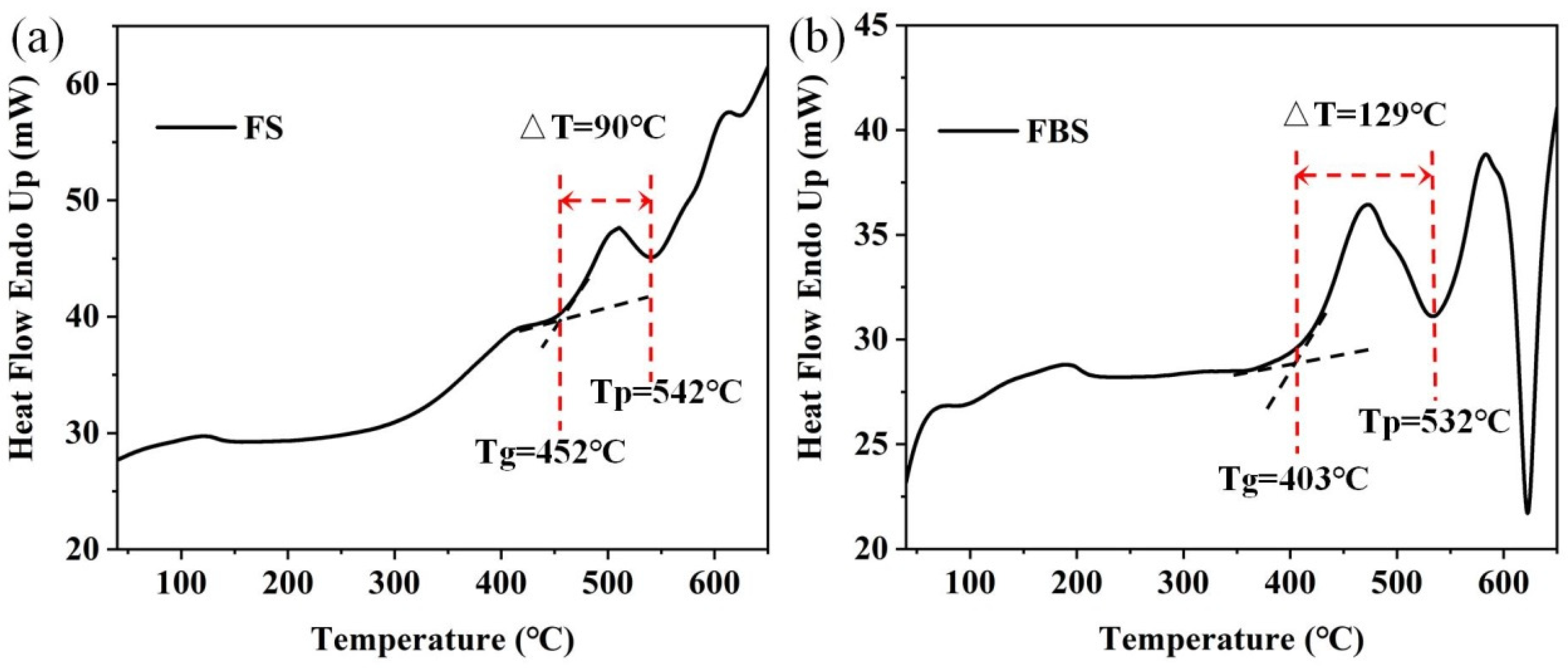
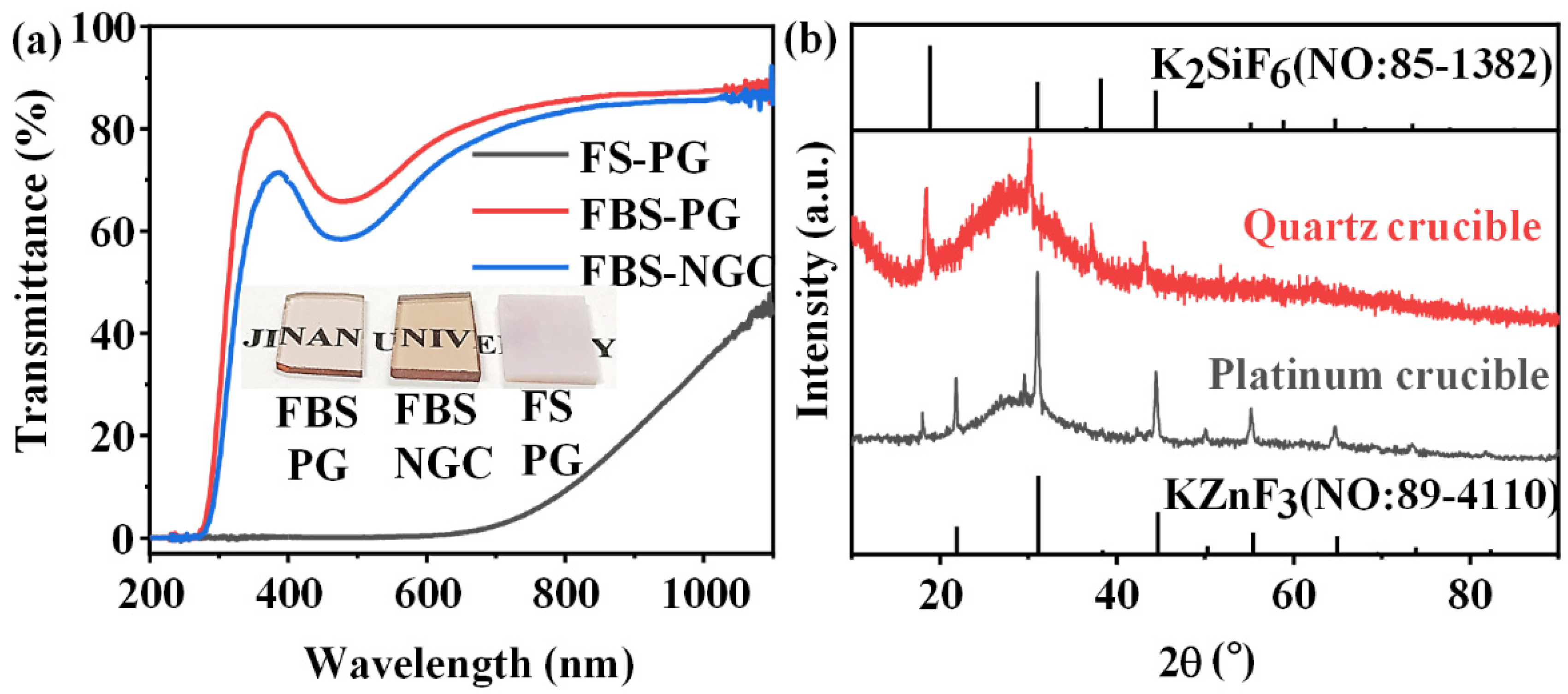
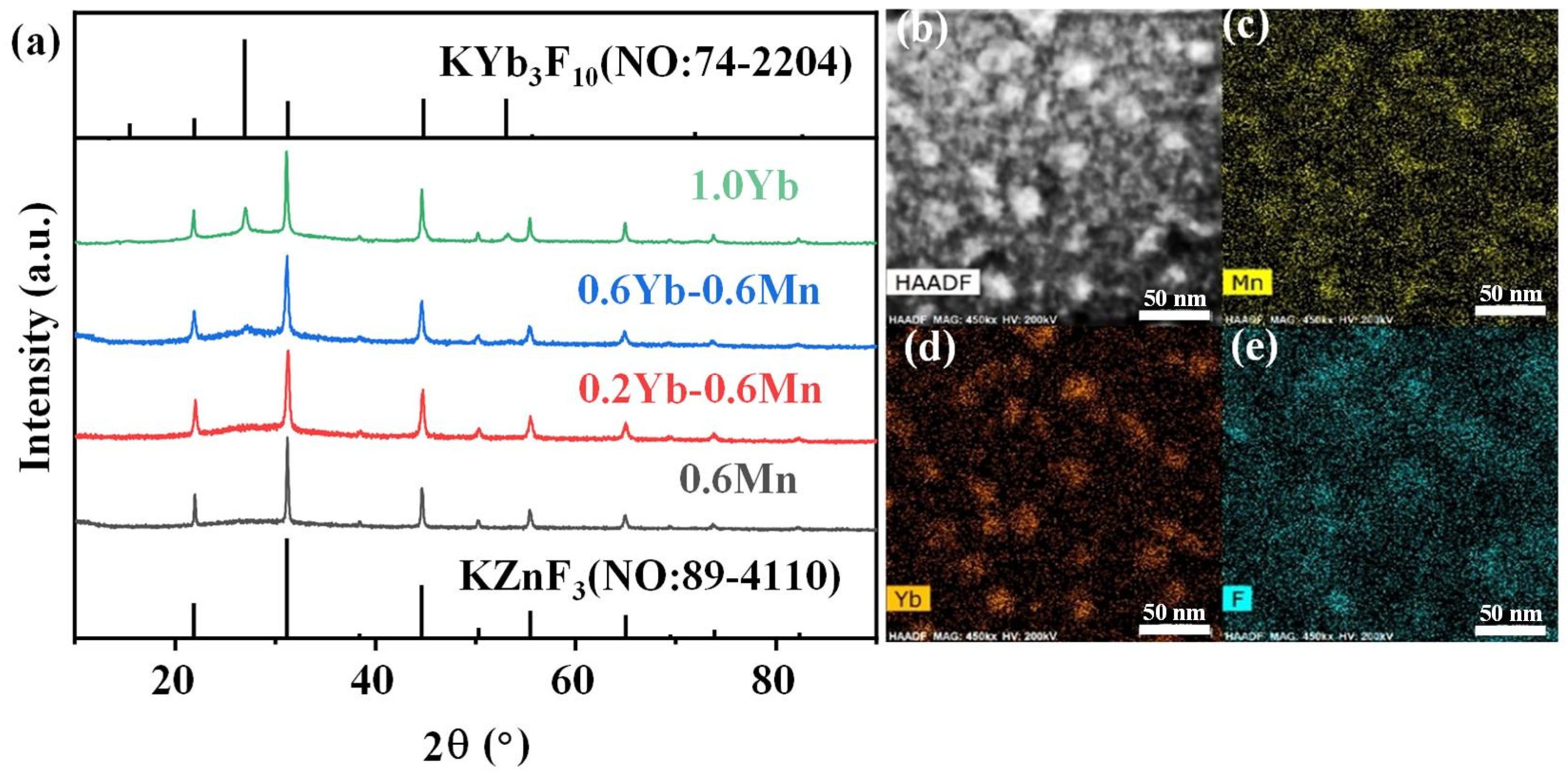

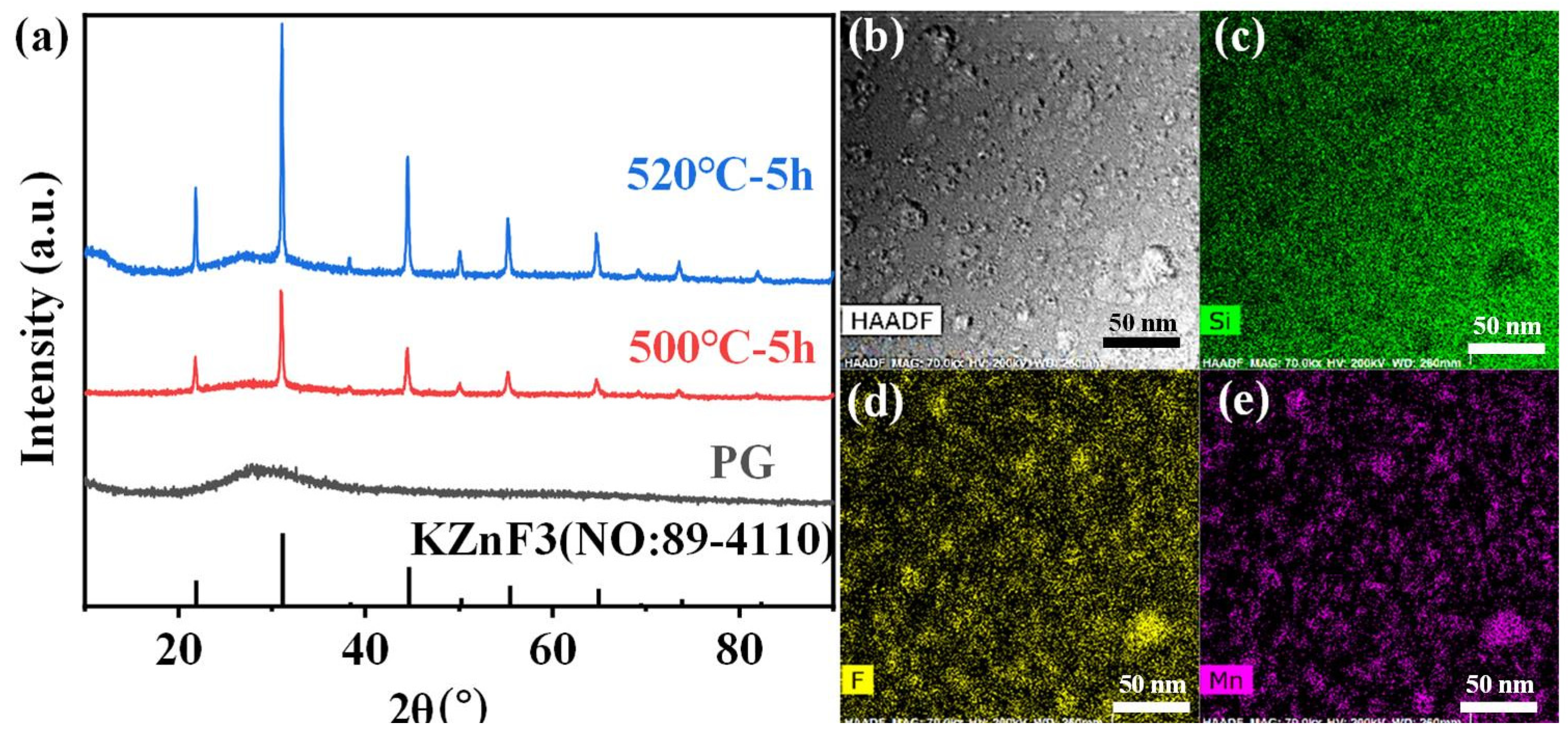

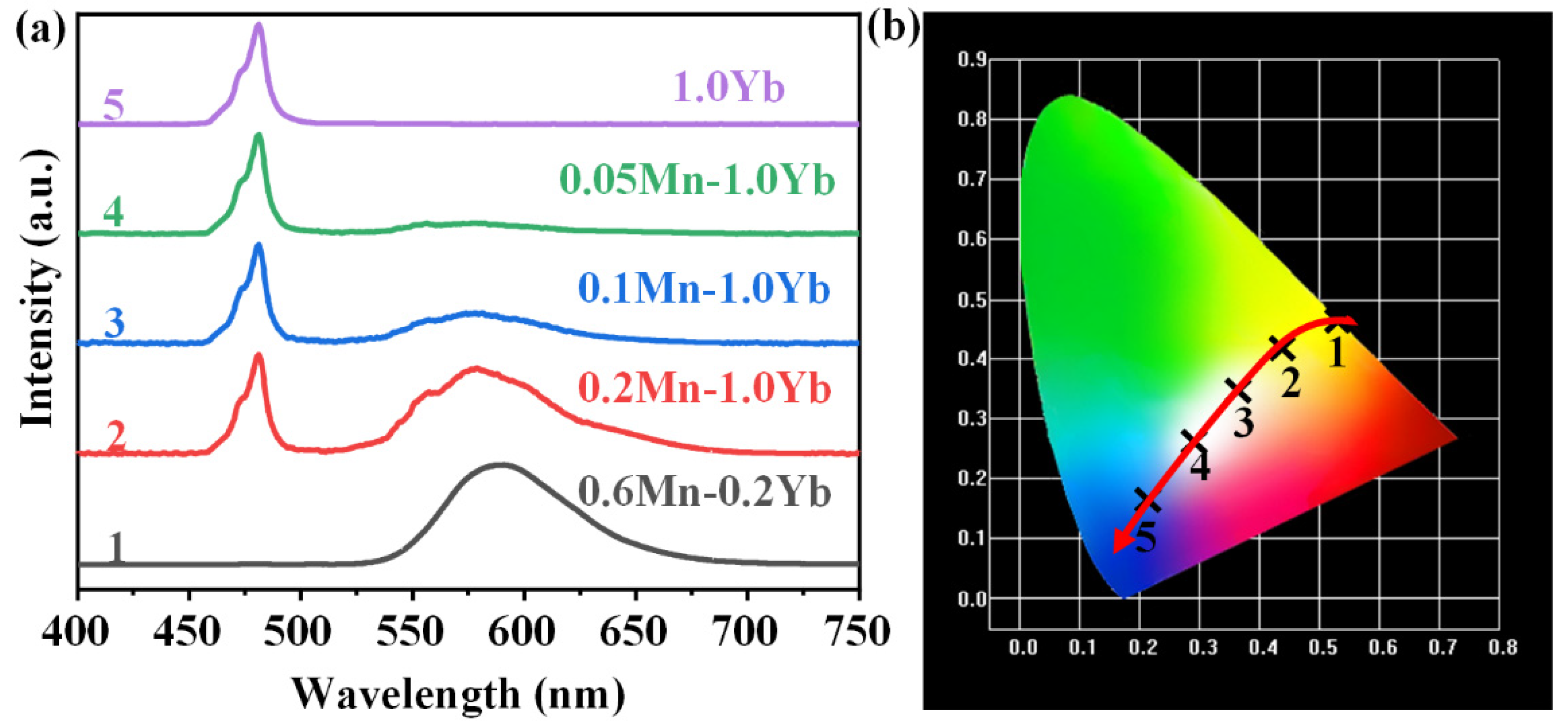
Disclaimer/Publisher’s Note: The statements, opinions and data contained in all publications are solely those of the individual author(s) and contributor(s) and not of MDPI and/or the editor(s). MDPI and/or the editor(s) disclaim responsibility for any injury to people or property resulting from any ideas, methods, instructions or products referred to in the content. |
© 2025 by the authors. Licensee MDPI, Basel, Switzerland. This article is an open access article distributed under the terms and conditions of the Creative Commons Attribution (CC BY) license (https://creativecommons.org/licenses/by/4.0/).
Share and Cite
Xiang, Y.; Long, Y.; Cen, P.; Liu, S.; Fang, Z.; Jiao, R. Controllable Nano-Crystallization in Fluoroborosilicate Glass Ceramics for Broadband Visible Photoluminescence. Nanomaterials 2025, 15, 144. https://doi.org/10.3390/nano15020144
Xiang Y, Long Y, Cen P, Liu S, Fang Z, Jiao R. Controllable Nano-Crystallization in Fluoroborosilicate Glass Ceramics for Broadband Visible Photoluminescence. Nanomaterials. 2025; 15(2):144. https://doi.org/10.3390/nano15020144
Chicago/Turabian StyleXiang, Yuanhang, Yi Long, Peiying Cen, Sirang Liu, Zaijin Fang, and Renjie Jiao. 2025. "Controllable Nano-Crystallization in Fluoroborosilicate Glass Ceramics for Broadband Visible Photoluminescence" Nanomaterials 15, no. 2: 144. https://doi.org/10.3390/nano15020144
APA StyleXiang, Y., Long, Y., Cen, P., Liu, S., Fang, Z., & Jiao, R. (2025). Controllable Nano-Crystallization in Fluoroborosilicate Glass Ceramics for Broadband Visible Photoluminescence. Nanomaterials, 15(2), 144. https://doi.org/10.3390/nano15020144





